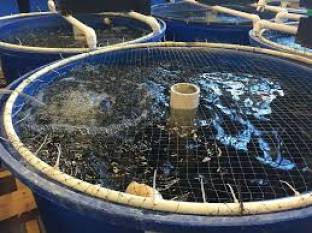MUMBAI, 20 November 2024: In the quest for sustainable aquaculture practices, Biofloc Technology (BFT) has emerged as a game-changing innovation.
This method, which utilizes beneficial microorganisms to transform waste into valuable resources, offers a sustainable solution to many of the challenges faced by the aquaculture industry, including waste management, disease control, and feed efficiency.
What is Biofloc Technology?
Biofloc Technology involves the cultivation of microbial communities within aquaculture systems. These microorganisms, known as bioflocs, form by aggregating suspended particles, waste, and bacteria into flocs that can be consumed by aquatic species. The process hinges on balancing the carbon-to-nitrogen ratio in the water, promoting the growth of heterotrophic bacteria that convert nitrogenous waste into microbial biomass. This microbial biomass is then ingested by the cultured species, such as shrimp or fish, providing a supplemental food source rich in protein.
Environmental Benefits
1. Waste Management and Nutrient Recycling:
One of the most significant advantages of BFT is its ability to recycle waste within the system. Traditional aquaculture methods often result in the accumulation of waste, leading to water pollution and the need for frequent water exchanges. In contrast, bioflocs convert waste products, such as uneaten feed and excreta, into microbial protein. This not only reduces the need for water changes but also lowers the risk of environmental contamination.
2. Water Conservation:
By recycling water within the system, BFT drastically reduces water usage compared to conventional aquaculture practices. This is particularly beneficial in regions where water scarcity is a critical issue. The closed-loop nature of biofloc systems ensures that water is used efficiently, contributing to the overall sustainability of the operation.
3. Disease Control:
Bioflocs create a competitive environment that inhibits the growth of harmful pathogens. The dense microbial community can outcompete pathogenic bacteria for nutrients, reducing the likelihood of disease outbreaks. This natural form of disease control can minimize the need for antibiotics and other chemical treatments, promoting healthier and more sustainable aquaculture practices.
Economic Advantages
1. Reduced Feed Costs:
Feed is one of the most significant expenses in aquaculture. Biofloc systems can substantially lower feed costs by providing an additional source of nutrition. The protein-rich bioflocs are consumed by the cultured species, reducing the reliance on commercial feeds. Studies have shown that biofloc-fed shrimp and fish exhibit improved growth rates and feed conversion ratios, leading to more efficient production.
2. Enhanced Growth and Yield:
The availability of continuous, high-quality nutrition from bioflocs can enhance the growth and overall health of the cultured species. This can lead to higher yields and better-quality produce, providing economic benefits to farmers. Furthermore, the improved growth rates can shorten production cycles, allowing for more frequent harvests and increased profitability.
3. Market Differentiation:
As consumers become more aware of and concerned about the sustainability of their food sources, aquaculture products raised using biofloc technology can command a premium in the market. The eco-friendly and sustainable nature of BFT can be a strong selling point, appealing to environmentally conscious consumers and providing farmers with a competitive edge.
Implementation and Challenges
While the benefits of biofloc technology are clear, its implementation requires careful planning and management. Farmers need to maintain optimal conditions for biofloc formation, including controlling the carbon-to-nitrogen ratio, aeration, and water quality parameters. This necessitates a good understanding of microbial ecology and the dynamics of the aquaculture system.
1. Technical Knowledge:
Successful implementation of BFT requires technical expertise and continuous monitoring. Farmers need to be trained in managing biofloc systems, understanding the interactions between microorganisms, and maintaining water quality. Investing in education and training is crucial for the widespread adoption of this technology.
2. Initial Investment:
Setting up a biofloc system may require a higher initial investment compared to traditional aquaculture setups. This includes costs for equipment, such as aerators and monitoring systems, as well as infrastructure for managing water quality. However, the long-term savings on feed and water, coupled with the potential for higher yields, can offset these initial costs.
3. System Management:
Maintaining the balance of the microbial community is critical for the success of biofloc systems. Overloading the system with organic matter can lead to detrimental effects, such as oxygen depletion and the proliferation of harmful bacteria. Continuous monitoring and adjustments are necessary to ensure the health and productivity of the aquaculture operation.
Success Stories and Future Prospects
Despite these challenges, numerous success stories from around the world highlight the potential of biofloc technology. In countries like Indonesia, India, and Brazil, small and large-scale farmers alike have adopted BFT with remarkable results. Increased yields, improved water quality, and reduced feed costs have been reported, showcasing the viability and benefits of this innovative approach.
As research and technology continue to advance, the future of biofloc technology looks promising. Integrating BFT with other sustainable practices, such as recirculating aquaculture systems (RAS) and renewable energy sources, can further enhance its efficiency and sustainability. Additionally, advancements in automation and data analytics can simplify the management of biofloc systems, making them more accessible to farmers worldwide.
In conclusion, biofloc technology represents a significant leap forward in sustainable aquaculture. By transforming waste into a valuable resource, BFT addresses critical challenges related to waste management, water usage, and disease control. Its economic benefits, coupled with its environmental advantages, make it a compelling choice for the future of aquaculture. As the industry continues to evolve, biofloc technology will undoubtedly play a pivotal role in creating a more sustainable and resilient food production system.
Image credit: fisheriesindia.com























